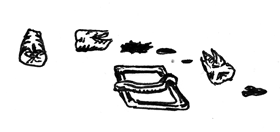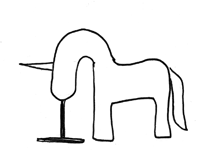OK, back to D&D!
I’ve been thinking about monsters that leave signs of their passing: creepy clues that mystify the PCs the first time they’re encountered. After the PCs have fought the monsters once, these clues allow the PCs to make informed choices about what’s behind the next dungeon door.
This was inspired a little by Mike Mornard’s tales of the original Gygax dungeons: outside a particularly dangerous part of the dungeon, the PCs might notice skulls and gnawed bones. Skulls and bones are so generic, though. Here are some extremely specific monsters and the strange trails they leave:
the teeth and buckles man
 The party comes upon a pile of scattered metal bits: belt buckles, coins, and a sword blade. Besides the metal items, there are a few dozen human teeth on the ground, along with a few splotches of blood. A hundred yards later, the party finds a similar pile of metal and teeth.
The party comes upon a pile of scattered metal bits: belt buckles, coins, and a sword blade. Besides the metal items, there are a few dozen human teeth on the ground, along with a few splotches of blood. A hundred yards later, the party finds a similar pile of metal and teeth.
Later, the PCs encounter a few leather-clad human guards. The weaponless guards wave the heroes, grinning, their pink mouths empty of teeth.
So here’s my idea: this monster, which is sort of like an extra-creepy doppelganger, eats people and then takes their form. It hates to touch metal, and it can’t do teeth: it can’t digest them and it can’t imitate them.
In battle, the Teeth and Buckles Man grabs and absorbs its prey. Its attacks are AC attacks that ignore the armor bonus of non-metal armor: it’s perfectly happy to eat leather. The creature’s grab does damage every round until the creature or the target are killed, or the target escapes. If a target is killed by the Teeth and Buckles Man, it takes the victim’s form: it sheds all metal and spits out the victim’s teeth before it continues.
The Teeth and Buckles Man is resistant to wooden weapons, like staves, and natural weapons like claws. Metal weapons and teeth do full damage.
I think that the Teeth and Buckles Man does its best to masquerade as its victim, the better to take any companions unawares. It’s not a very effective ruse, though, because the monster can’t talk, and is unaware that its toothless smile is unnerving.
The Red Unicorn
 The PCs find that a section of the dungeon is criss-crossed with many thin trails of dried blood, like one of those fancy desserts drizzled with chocolate. Eventually, the PCs find that a blood trail down one of the corridors is fresh and red.
The PCs find that a section of the dungeon is criss-crossed with many thin trails of dried blood, like one of those fancy desserts drizzled with chocolate. Eventually, the PCs find that a blood trail down one of the corridors is fresh and red.
The players might well freak out and refuse to investigate. If they follow the trail, they’ll eventually corner a white unicorn. From the beast’s mouth drips an endless rope of bloody drool. The unicorn will attack in a panicked frenzy.
If the PCs incapacitate or kill the unicorn and investigate, they will find that something strange is lodged in the unicorn’s throat: maybe a black iron burr, or a wide-eyed silent toad, or a small dancing man with arrowheads instead of feet. If this object is placed into any creature’s mouth, that creature will drool endless blood and attack all creatures on sight.
It’s always tempting to use unicorns as victims of the tragic and grotesque. Maybe one of these days I’ll include a healthy, happy unicorn in one of my games.
Here’s why I think this is a good idea: Bizarre monster details aside, I think it is good to give players some basis on which to make decisions. “Do you turn right or left?” and “Do you open the door or not?” are not compelling decisions unless you have an inkling what’s to the right or what’s behind the door. Many wandering monsters could profitably be exchanged for signs of the wandering monsters’ presence, enticing or warning the PCs about what’s ahead.








I love the unicorn having something horrible in its throat. Like it starts horrible and then rewards curiosity with more horror
Hey. If you are going to reference The Thing, give it a shout-out so people that don’t know can discover it.
I actually haven’t seen The Thing, but from wikipedia it does look like they’re assimilating doppelgangers, right? So sure, people should probably see it: most stuff by John Carpenter is pretty entertaining.
The bit about the skulls and gnawed bones reminds me of the videogame adaptation of Deathtrap Dungeon. The one really cool thing about it was the way it used bones not just as indications that a place was dangerous, but as clues to what sort of danger to expect. For example, if you saw a headless skeleton lying on the ground, it meant you should be watching for a trap capable of decapitation — say, a blade that comes out of the wall at neck height.
[…] of Holding had some deep thoughts about monsters this week – what kinds of traces do the monsters leave behind? What kinds of clues would they […]
Awesome!! Too cool! (swiped)